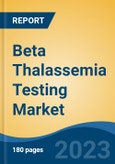Speak directly to the analyst to clarify any post sales queries you may have.
10% Free customizationThis report comes with 10% free customization, enabling you to add data that meets your specific business needs.
The rising demand for genetic risk assessment is accelerating the adoption of advanced molecular diagnostic tools, which are enhancing the accuracy and efficiency of early diagnosis and improving long-term disease management. Technological advancements - such as next-generation sequencing (NGS), polymerase chain reaction (PCR)-based diagnostics, and non-invasive prenatal testing (NIPT) - are making testing more accessible, efficient, and cost-effective, particularly in regions with a high disease burden.
Key Market Drivers
Rising Global Prevalence of Beta Thalassemia
The growing global incidence of beta thalassemia is a primary catalyst for the market’s expansion. Approximately 1.5% of the global population carries the β-thalassemia gene mutation, with higher prevalence observed in the Mediterranean, Middle East, South Asia, and Southeast Asia. The disorder affects an estimated 80 to 90 million individuals, driving significant demand for genetic testing, prenatal diagnostics, and carrier screening in these high-risk regions.Each year, approximately 60,000 infants are born with β-thalassemia major, the majority in developing nations where access to diagnostic and therapeutic options is limited. Countries including India, Pakistan, Bangladesh, and Iran report particularly high prevalence rates, prompting governments and healthcare institutions to implement mandatory screening programs and improve diagnostic infrastructure.
Furthermore, the global migration of at-risk populations is expanding the geographic scope of beta thalassemia testing, increasing demand in regions such as Europe and North America. As the disease burden intensifies, health authorities are focusing on comprehensive testing strategies, thereby propelling the growth of specialized diagnostic markets.
Key Market Challenges
Limited Access to Healthcare in Low-Resource Settings
Despite rising demand, the beta thalassemia testing market faces constraints in developing and underserved regions, where healthcare infrastructure is often underdeveloped. A lack of medical facilities, trained personnel, and financial resources hampers the early diagnosis and management of beta thalassemia.These limitations present significant barriers to market penetration, particularly in rural areas and low-income countries where the disease is most prevalent. Expanding diagnostic services in such environments requires considerable investment in infrastructure, education, and healthcare delivery systems. Market participants may face logistical and operational challenges when establishing testing facilities in these regions.
Key Market Trends
Increased Adoption of Non-Invasive Prenatal Testing (NIPT)
A transformative trend within the beta thalassemia testing market is the rapid adoption of non-invasive prenatal testing (NIPT). By analyzing fetal DNA from a maternal blood sample, NIPT offers a safe, accurate, and early method of detecting beta thalassemia without the risks associated with invasive procedures such as amniocentesis or chorionic villus sampling (CVS).NIPT provides several advantages: high diagnostic precision, minimal risk to the fetus, and greater convenience for expectant parents. Growing awareness around early diagnosis and the availability of safer prenatal testing options is driving the widespread acceptance of NIPT.
Technological advancements in genomic sequencing and declining testing costs are making NIPT increasingly accessible to broader patient populations. As a result, diagnostic laboratories and healthcare providers are investing in NIPT infrastructure to meet rising demand and expand their prenatal screening services. This trend is expected to significantly boost market growth, particularly in regions with increasing emphasis on maternal-fetal health.
Key Market Players
- MedGenome
- 3B BlackBio Biotech India Limited
- Bio-Rad Laboratories Inc.
- ViennaLab Diagnostics
- Thermo Fisher Scientific Inc.
- PerkinElmer Inc.
- BioMedomics Inc.
- Asper Biogene
- Tosoh Bioscience Inc
Report Scope:
In this report, the Global Beta Thalassemia Testing Market has been segmented into the following categories, in addition to the industry trends which have also been detailed below:Beta Thalassemia Testing Market, By Product:
- Kits
- Consumables
Beta Thalassemia Testing Market, By Technology:
- Prenatal Diagnosis
- Complete Blood Count
- DNA Testing
- Others
Beta Thalassemia Testing Market, By Type:
- Thalassemia Major
- Thalassemia Intermedia
Beta Thalassemia Testing Market, By End-User:
- Hospitals & Specialty Clinics
- Diagnostics Centers
- Others
Beta Thalassemia Testing Market, By Region:
- North America
- United States
- Canada
- Mexico
- Europe
- France
- United Kingdom
- Italy
- Germany
- Spain
- Asia-Pacific
- China
- India
- Japan
- Australia
- South Korea
- South America
- Brazil
- Argentina
- Colombia
- Middle East & Africa
- South Africa
- Saudi Arabia
- UAE
Competitive Landscape
Company Profiles: Detailed analysis of the major companies present in the Global Beta Thalassemia Testing Market.Available Customizations:
With the given market data, the publisher offers customizations according to a company's specific needs. The following customization options are available for the report.Company Information
- Detailed analysis and profiling of additional market players (up to five).
This product will be delivered within 1-3 business days.
Table of Contents
Companies Mentioned
- MedGenome
- 3B BlackBio Biotech India Limited
- Bio-Rad Laboratories Inc.
- ViennaLab Diagnostics
- Thermo Fisher Scientific Inc.
- PerkinElmer Inc.
- BioMedomics Inc.
- Asper Biogene
- Tosoh Bioscience Inc
Table Information
| Report Attribute | Details |
|---|---|
| No. of Pages | 180 |
| Published | April 2025 |
| Forecast Period | 2024 - 2030 |
| Estimated Market Value ( USD | $ 0.6 Billion |
| Forecasted Market Value ( USD | $ 1.03 Billion |
| Compound Annual Growth Rate | 9.2% |
| Regions Covered | Global |
| No. of Companies Mentioned | 9 |









